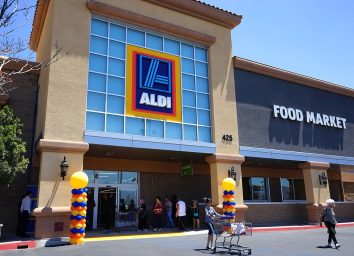What to Do If You Live in a Food Desert

Imagine living in a world without fresh food—no grocery store in sight—a world where the only meals are from the fast food restaurant down the street. You get your protein from a warmed-up frozen patty; your veggies from a pickle slice; your fiber from a soggy sesame-seed bun. You want to eat healthier, but can’t. Your kids eat a Happy Meal for dinner most nights, more sad than happy.
It sounds like the premise of a post-apocalyptic movie, but this is the reality for millions of Americans living in a “food desert.” In 2009, the USDA estimated that 23.5 million Americans lived in a low-income area and more than one mile away from a supermarket or large grocery store. (Note: About half of these people make a low income, and the other half live within the census tract that’s considered a low-income area.) When there’s a family to feed and cost restrictions to be mindful of, fast food often becomes the main food source for individuals living in these regions, especially with the ever-growing prevalence of these chain restaurants popping up nationwide. In fact, the Economic Research Service (ERS) U.S. Department of Agriculture (USDA) Food Environment Atlas revealed that the number of fast food restaurants in the U.S. increased by 9 percent between 2009 and 2014.
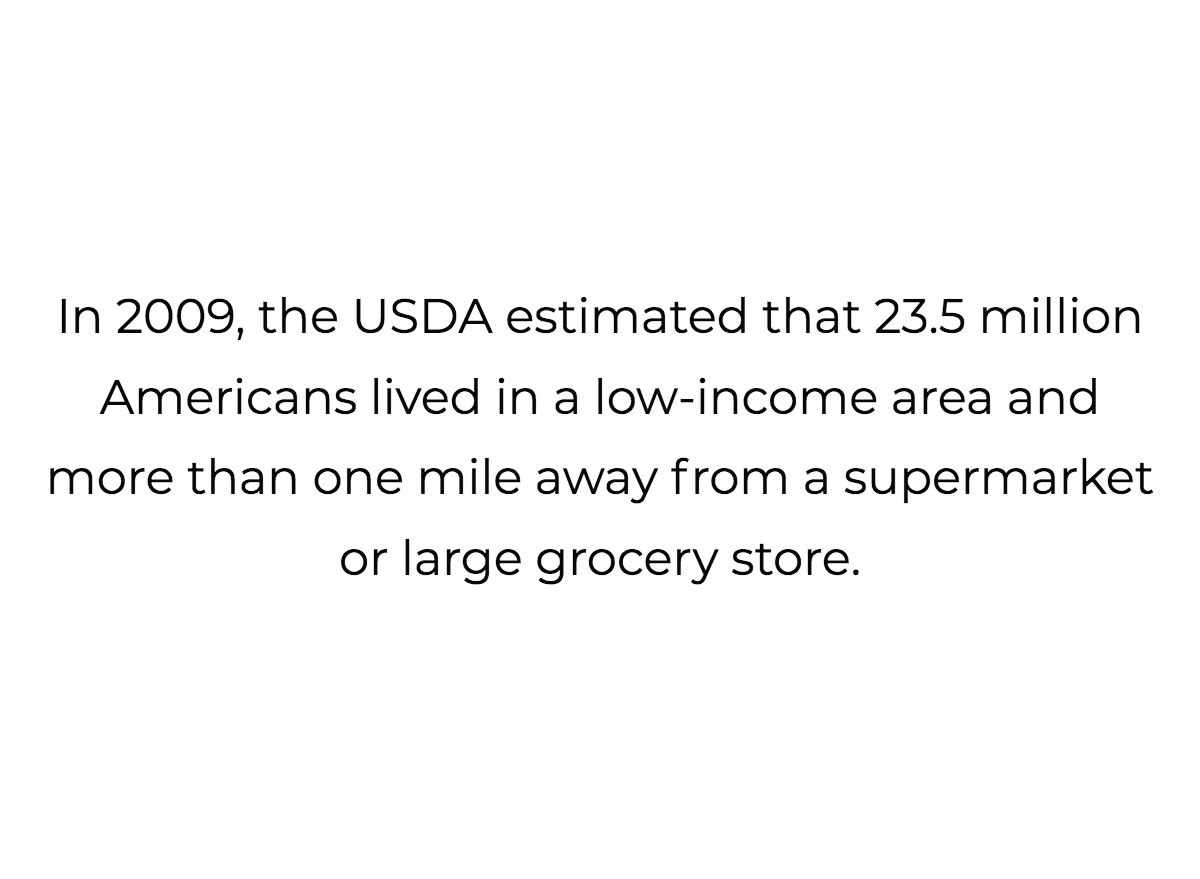
Alternately, some families live just a few steps away from a convenience store, corner store, or even a gas station. However, what these places and fast food restaurants have in common is this: they all fail to provide fresh, healthful food such as fruits and vegetables to the local community.
So where are these food deserts, and what can you do if you live in one? Eat This, Not That! set out to investigate.
What is a food desert?
The USDA defines a low-access census tract for an urban area as one where at least 500 people or 33 percent of the population lives more than a half mile away from the closest supermarket, supercenter, or large grocery store. For a rural area, 10 miles is the cutoff. Keep in mind, this measurement does not account for small food outlets like independent grocers. However, it’s arguably the most comprehensive analysis of food deserts in the U.S. that’s currently available.
This number of 23.5 million Americans does not take into account another very important factor. Aside from income and proximity to a store, you need access to a vehicle.
According to Michele Ver Ploeg, chief of the Food Assistance Branch at the ERS within the USDA, “Nationally, about 4.2 percent of households…don’t have a car and are more than a half mile away from the store.” This share even accounts for the number of people who live more than 20 miles away from a grocery store, regardless of vehicle access. “Now it turns out, only about a half million people in the U.S. fit that definition of living more than 20 miles away from a store,” says Ver Ploeg. However, traveling that kind of distance just to get food is enough to constitute it as a burden, and shopping for food at convenience stores and eating at fast food restaurants nearby is inevitably much easier to do day to day.
Having limitations to food access does not look the same for everyone, and there are many factors to consider as well, such as age, physical disabilities, and the cost of living in certain areas. In other words, there are a lot of other barriers aside from the big three: income, proximity to a store, and access to a vehicle.
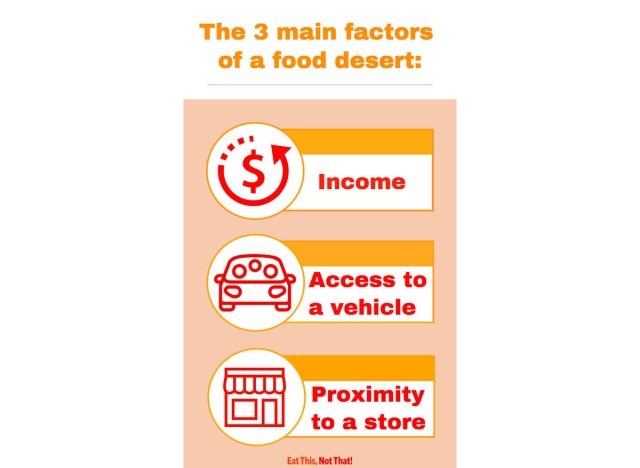
What are the telltale signs that you live in a food desert?
The most consistent characteristic of a food desert is having a lack of access to fresh, healthful food. Living in a food desert doesn’t necessarily mean there’s no food available; it means that there are no healthy options readily available.
Some food desert territories have an abundance of convenience and corner stores, but a scarcity or lack of healthy foods, which actually lends the area another name.
In an email with Anne Palmer, the Food Communities and Public Health program director at the Johns Hopkins Center for a Livable Future, she writes, “I don’t think the food desert term tells the whole story, as it implies a lack of food. In many low-income neighborhoods, the stores available to residents are small convenience and corner stores that are stocked with ready-to-eat foods, mostly high in sugar, salt, or fat. Some researchers have used the term ‘food swamp’ to characterize neighborhoods with an abundance of small stores.”
Dr. Charles Platkin, editor of health site Diet Detective and executive director of the Hunter College New York City Food Policy Center, emphasizes that in a food swamp “there may be a low availability of healthy food access, and there might be an overabundance of unhealthy food access, which is not a great formula for success in terms of healthy living.”
Kelly Verel, vice president of Project for Public Spaces and a specialist in public markets, concurs, writing in an email that it is not enough to just have a store that sells some type of food nearby, but rather “it needs to offer produce, proteins, and other food items that are of high quality.” She also writes, “I actually think that the USDA’s definition of a food desert holds up relatively well, but of course, the most important element is quality food.”
Palmer also stresses that not having access to any form of transportation and living in a neighborhood with households that all make below $40,000 a year are two other such signs that you live in a food desert.
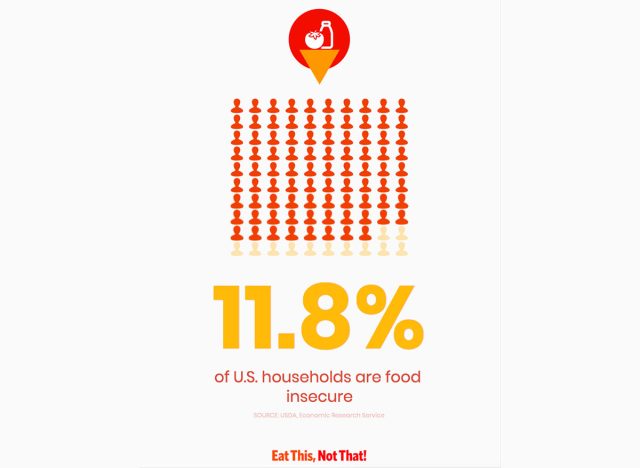
Why is this a huge issue?
Not having access to healthful foods and only having access to heavily processed packaged foods can put one at risk of chronic ailments such as type 2 diabetes and cardiovascular disease. However, what’s even more concerning is the trapping aspect of a food desert. After all, low-income residents are likely not living there by choice.
“It’s not enough to say, ‘Well if you’re in a food desert, just move to a better area,'” writes Andrew Mayle, food and nutrition division director for Hocking Athens Perry Community Action in Ohio, in an email.
“Food insecurity comes with a strong stigma. There is a culture of poverty we notice where people believe that poverty and going hungry is a result of personal decisions,” he says.
Poverty is very prevalent in some of these food desert regions, and it is even thought to be the root of the problem. In fact, 11.5 million people—which is to say about 4.1 percent of the U.S. population—make an income that is either at or below 200 percent of federal poverty thresholds and they live more than one mile away from a grocery store.
Additionally, 11.8 percent of U.S. households are considered food insecure, which is to say that at some point during the year, these households were either uncertain of having, or unable to obtain, an adequate amount of food to feed their family due to insufficient income or lack of food resources.
While several measures can be taken to help fight food insecurity, many of which will be discussed later, the root of these problems will largely be solved within the government, as it is a systemic issue at its core.
“You need policymakers, politicians, and community leaders to prioritize public health, specifically ensuring that people can access their entitlements and also advocating for quality food. That is easier in some communities than others,” says Verel.
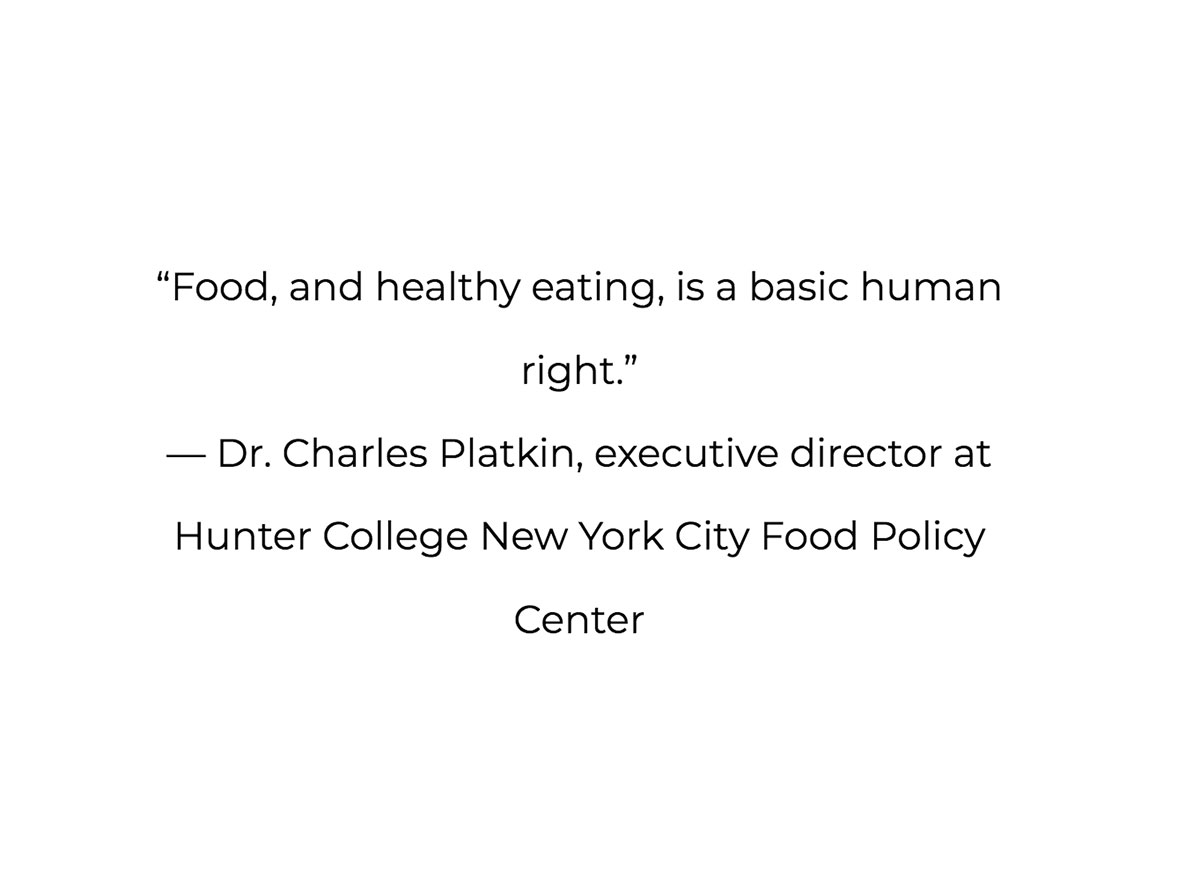
And even then, advocacy programs and grassroots movements formed at the local level may provide aid for immediate relief, but it will take time and systemic changes to see improvements at the roots of the problem and the health outcomes that are believed to develop as a result of low income and low access to fresh food.
“So we know that by just creating accessibility to food, making sure it’s available, doesn’t necessarily mean all of a sudden it will add up to dramatic decreases in diet-related chronic diseases,” says Platkin. “It also doesn’t necessarily mean you’re going to see dramatic changes in food insecurity, meaning a reduction in food insecurity and hunger-related issues.”
A quick-fix does not exist for those living in a food desert, but that doesn’t mean you don’t have options if you’re living in a food desert and need food assistance. Platkin, as well as the other sources in this article, point out that introducing something like a farmers market into a community that’s burdened by a food desert won’t automatically result in an instant reduction in food insecurity or a dramatic drop in the diabetes rate among that community. However, any form of change is a step in the right direction and gives people the immediate help they need to survive.
“One of the things that I think is such an important focus and concept is that food, and healthy eating, is a basic human right,” says Platkin.
Food deserts can look drastically different, especially among rural and urban areas. Take a more rural area like Athens County, Ohio, and an urban area such as Memphis, Tennessee, as an example in the below two graphics.
Ver Ploeg explains that the yellow areas are census tracts that are low-income and have at least 100 housing units that do not have a vehicle and are at least 1/2 mile from the nearest supermarket, supercenter, or large grocery store. Note: None of these tracts meet the 20 mile part of that definition—i.e. they do not have at least 500 people or one-third of the census tract population living more than 20 miles from a store.
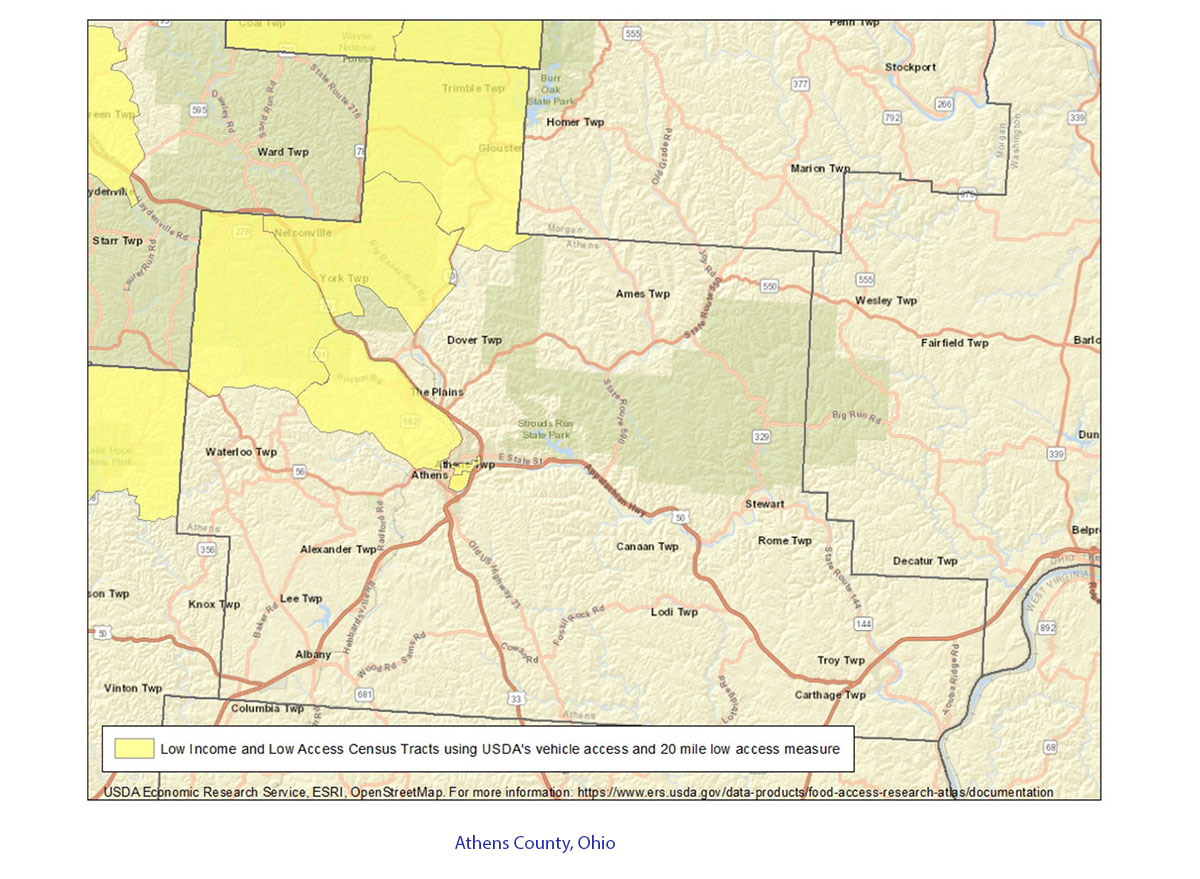
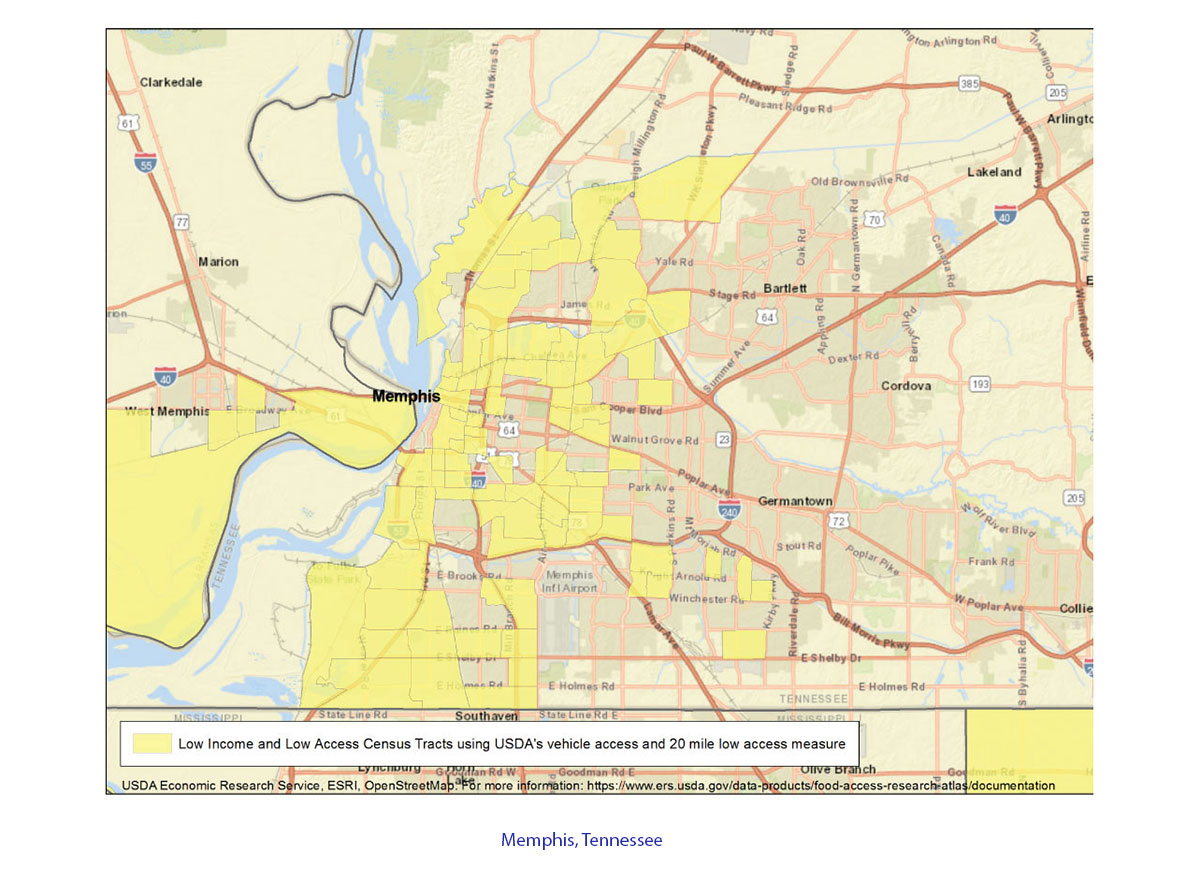
What do processed foods do to your body?
There is no avoiding processed foods when you live in a food desert or food swamp, and eating processed foods over time may pose a serious threat to your health. The Centers for Disease Control and Prevention says that while some studies have shown that food deserts can negatively impact overall health (through obesity, diabetes, and heart disease), more research must be done in order to demonstrate exactly how that influence may occur.
What we do know is that high cholesterol levels can make you more susceptible to heart disease, which is the leading killer in the U.S. According to the CDC, one in every four deaths is attributable to heart disease. Meat and dairy products both contain the artery-clogging type of cholesterol, known as LDL. Eating burgers or breakfast sandwiches with sausage, bacon, eggs, and cheese often all contribute to higher cholesterol levels, and these items are always readily available at fast food restaurants.
Processed foods also tend to be high in sugar, which can lead to a host of health issues as well, including obesity and type 2 diabetes. So while there isn’t currently enough research behind whether or not living in a food desert causes bad health outcomes, we do know that eating these kinds of processed foods regularly can put you at risk for such outcomes.
What healthier food items may be available to you when shopping for food?
With a low income and sparse trips to the grocery store, receiving adequate nutrition can be a challenge when living in a food desert. We here at Eat This, Not That! want to demystify the idea that you can’t eat healthy on a budget when you shop, whether you can only head to a gas station or convenience store or if you can make it to a grocery store or farmers market. Below, we offer some tips on which healthful foods we think may be more affordable than others and even provide insight on which foods are better for you than others in places like gas stations and convenience stores, too.
Eggs are a great example of a food that provides nutrition, primarily fat and protein, for an inexpensive price. Of course, it depends on where you live. In urban areas that are far from farmland, eggs can have a higher price tag. In some states, a dozen eggs can cost less than $1. However, let’s say a dozen eggs is $1.66 at the nearest grocery store, that means each egg only costs you between 13 and 14 cents. Eggs can be incorporated into a variety of dishes, too. From breakfast staples such as scrambles and omelets to heartier meals like stir-fries and egg salad. They’re a cheap way to add protein to your diet at breakfast, lunch, or dinner.
There are also other food items out there that cost less than a dollar—again, depending on where you live—but prove even if you don’t have a ton of money to spend, you can still find something to eat that is filling and nutritious. An apple, a serving size of almonds, and even a stick of organic string cheese all typically cost less than a dollar each.
Other food items we recommend you buy in bulk, like lentils, rice, and oats. Oftentimes, purchasing these items in bulk will be cheaper than buying them in pre-packaged individual bags. Not to mention, this also gives you the authority to scoop out the exact amount you want.
Fresh fruits and vegetables can be expensive, especially when they’re being sold outside of their growing season. During these months, it may be better to buy these goods from the frozen foods section.
“Frozen food is an under-utilized, or at least an under-promoted product that can help extend food resources throughout the month,” says Palmer.
Not all frozen foods are unhealthy either. You might think only of the sodium-packed TV dinners of the past, but there are several brands that sell healthy frozen meals. However, they often come with a higher price tag, so be sure to see if there are any deals or promotions running. Sometimes, grocery stores will run specials if you buy multiples, so keep an eye out in the weekly flyer for deals.
Finally, if you don’t have any means of transportation to get to a grocery store and a gas station or convenience store is all that’s close to you, consider sifting through the aisles—instead of looking at the checkout counter—for healthier packaged goods. For example, opt for a bag of almonds instead of a bag of chips, or peruse the refrigerated section of the station or convenience store for a Sabra Hummus to-go snack cup with pretzel thins. While in this section, be on the lookout for plain yogurt and string cheese, too, which are healthy ways to get calcium.
What can you do if you live in a food desert?
Whether you need assistance or are in a position to help those in a food desert, there are resources for you to utilize and ways you can help fight food insecurity in your area.
To get started, here are seven resources you can use if you’re in need of assistance and four ways you can help in your area.
If you’re in need of food assistance:
1. See if you live near a community garden.
“During the growing months, if you have time and energy, you can participate in community gardens,” says Palmer. A community garden is a great way to make use of unused space and feed a community.
The American Community Garden Association provides resources for roughly 18,000 community gardens throughout the U.S. and Canada. The “Find a Garden” tool on their site helps you identify a community garden near you. Gardens can be found in both urban and rural areas.
In New York City, Harlem Grown works to increase both access and knowledge of healthy food to nearby residents. At Harlem Grown, children have the opportunity to get hands-on farming experience and learn about sustainability, urban agriculture, and even healthy cooking along the way.
2. See if you’re eligible for SNAP.
SNAP and WIC are two governmental programs that could assist you. Platkin points out that while these two sources may not always offer fresh produce, they will provide some sort of food if you and your family are at risk of being hungry. There are some farmers markets that accept food stamps and implement what’s called the WIC Farmers’ Market Nutrition Program. You can see which states participate here and use the USDA’s National Farmers Market Directory to find the closest farmers market to you.
3. See if your farmers market or food distributor donates leftover produce.
Nonprofit organization Gather Baltimore is an example of a group of volunteers that collects food that didn’t sell at farmers markets and excess produce from distributors and local farms. The Farmers Market Recovery Program by Food Forward is another organization that works to reduce food waste and distribute leftover food to those in need. Food Forward rescues food from 23 different farmers markets between Los Angeles and Ventura Counties. They rescue an average of 52,000 pounds of food per month and pass the food off to hunger relief agencies who then distribute the food to their clients within three days.
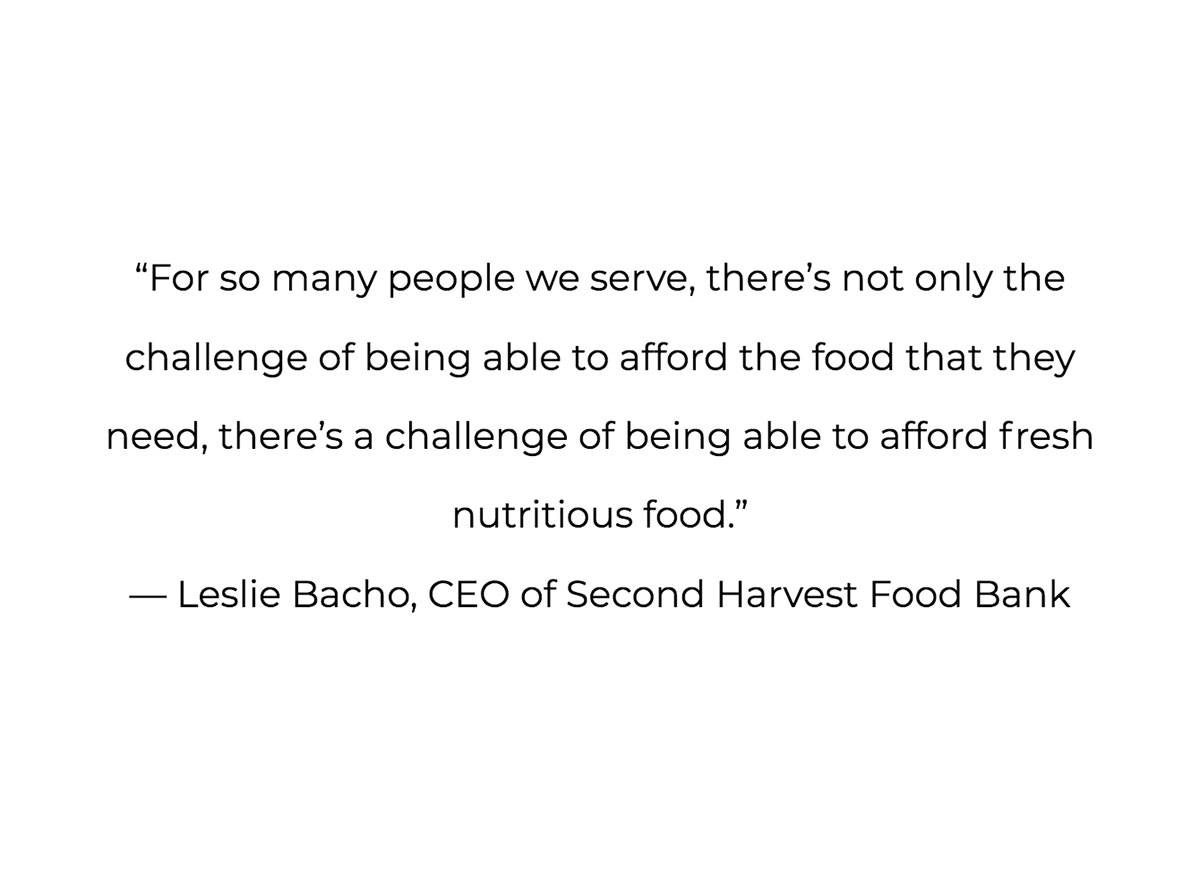
4. See if your local food bank offers any additional support.
Second Harvest Food Bank in Silicon Valley works to reduce food waste from local distributors and puts that food toward pop-up farmers markets the food bank sets up at schools, community centers, and senior housing complexes. The cost of living in Santa Clara and San Mateo counties is very high. In these counties, Leslie Bacho, CEO of Second Harvest Food Bank, says that heads of households may be working multiple jobs just to make ends meet. For perspective, the department of housing and urban development (HUD) says that a family of four earning $94,450 a year or less in Santa Clara County or $117,400 a year or less in San Mateo County is considered low-income and could qualify them for food assistance. This illustrates just how different food insecurity looks across the nation.
“In many low-income neighborhoods, there’s just not good access to groceries, and fresher items are more expensive,” says Bacho. “For so many people we serve, there’s not only the challenge of being able to afford the food that they need, there’s a challenge of being able to afford fresh nutritious food.”
The Southeast Ohio Foodbank in Logan, Ohio, offers a Summer Feeding Program to all children 18 years or younger, regardless of household income.
“Low-income families living in a food desert have a hard time supplying highly nutritious meals every day of the week. Often, we find that free school breakfasts and lunches are the only meals children can rely on during the week. When the school year ends, there’s a significant meal gap during the summer months,” says Mayle.
The Summer Feeding Program allows kids to receive one meal a day throughout the summer months at respective feeding sites. In addition, SE Ohio Foodbank also donates surplus produce from the Ohio Agricultural Clearance program, which accumulates produce from over 100 producers and growers in Ohio to families who visit the feeding sites.
“This allows them to take food home to prepare during the weekends when our feeding sites are not operating. We want to ensure that no child goes without a meal,” says Mayle.
5. See if mobile markets or food delivery services are an option for you.
There are several mobile markets operating throughout various parts of the U.S. For example, Twin Cities Mobile Market is a giant green bus that brings anything from fresh fruits and vegetables to grains, meat, and dairy products to various neighborhoods in Saint Paul and Minneapolis, Minnesota, and sells the items for an affordable price. This market also accepts SNAP.
Second Harvest Food Bank in Silicon Valley has 17 trucks that deliver food to those in need. About two years ago, the food bank teamed up with Starbucks to distribute even more fresh food. In Silicon Valley, 1 in 4 residents are at risk of hunger, 25 percent of which are families with children. Each night, Bacho says that employees of Second Harvest collect leftover grab-and-go items (such as the bistro boxes and breakfast sandwiches) from over 100 Starbucks in the area every night. This does not cost the clients receiving the food any money at all.
“Through this partnership, Starbucks actually provides a truck, a refrigerated truck, and they help cover the salaries of the drivers that go to these stores every night to pick up these items and they go directly to our partners that are homeless shelters,” says Bacho. “It’s a great way for Starbucks to reduce their waste and for people who could really use the food assistance to get some very high-quality items.”
Meals on Wheels America is another such service that delivers meals to those in need, specifically those who are 60 years of age and older. Jenny Young, the vice president of communications for Meals on Wheels America, says that the food delivery service operates in just about every community in the U.S. via a network of over 5,000 independently-run local programs. There are a lot of seniors in the U.S. who face hunger and isolation that need this service, regardless of whether they live in a food desert or not.
“Food insecurity remains a persistent challenge in the United States, with nearly 9 million older Americans not knowing where their next meal will come. Older adults face unique challenges when it comes to food security along [with] a continuum of need,” Young writes in an email.
Young also says that food deserts only complicate this scenario further for seniors with limited mobility, because not only do they live in a low-access area, but they also are unable to travel far distances to go retrieve healthful foods.
“Meals on Wheels is designed to deliver nutritious meals to isolated seniors who may struggle with food security due to a number of reasons—whether they live in a food desert, a remote rural area, or simply cannot leave the house or prepare meals for themselves,” says Young.
6. Visit a food pantry or food bank for “emergency food.”
If you are in need of food, regardless of whether it provides fresh produce or not, a food pantry is another great resource to utilize. However, as both Platkin and Palmer address, emergency food assistance programs are only a short-term solution.
“It seems like people are depending on the food banks and food pantries to sustain their ability to eat in general, and that long-term sustainability is not what they’re designed for,” says Platkin. “People are consistently having to rely on food banks to feed themselves.”
Palmer says something of similar nature: “I’m sure using emergency food resources only help to a certain extent.”
While canned and packaged goods are typically the only foods available at food pantries, there are several thousand food pantries out there that do provide fresh and healthful options, too. For example, AmpleHarvest.org is a nonprofit resource that links 42 million Americans who grow food either in their own gardens or at community gardens to 8,444 registered food pantries nationwide. Gardeners donate their excess harvest to these pantries, which helps to reduce food waste and supply those who are hungry with the nutrition they need.
7. Sign up for a Community Supported Agriculture (CSA) program.
Community Supported Agriculture programs provide members with a box of goods from nearby farms, including fresh, local produce and other farm products. CSA programs are not an option for everyone living in food deserts, though. These programs oftentimes require you to pick up your box of farm goods. Not to mention, it also costs money to receive such healthful produce straight from the farm. It’s possible that community benefit programs can provide support to subsidize these boxes for families that cannot afford it otherwise. Local Harvest created a tool that helps you identify where the nearest CSA program is to you.
If you’re able to help:
1. Organize a food drive.
A food drive is a great way to provide resources to underserved communities. Create the Good provides a toolkit that can help get you started. You can collect food or monetary donations to purchase food for your local food bank to distribute to those in need. One way you can find the closest food bank to you is by using the “Find Your Local Food Bank” tool created by Feeding America. A food drive can take place in the course of one day or over several days. You can ask people to drop food off at a specific location, set up collection points, or host a food drive during a local event such as a football game. Inform your local media or spread the word via social media, so you can get a lot of people to contribute.
2. Participate in rideshares.
As mentioned above, one of the three main barriers that those who live in food deserts face is not having access to a vehicle. You can organize a group of people who have vehicles and would be willing to drive people to and from the grocery store. One idea is to have everyone meet at the office of a local nonprofit organization or a place of worship and coordinate a drive to and from the grocery store from there.
There also may be an opportunity for local nonprofit organizations to form a partnership with existing rideshare services. Last year in Washington, D.C., nonprofit organization Martha’s Table partnered with Lyft to create the Lyft Grocery Access Program, which allows residents living in Wards 7 and 8 that qualify to get a ride to and from the nearest grocery store for a round-trip flat fare of just $2.50.
3. Advocate for the development of a nonprofit grocery store in your area.
Residents of Chester, Pennsylvania, had been without a grocery store since 2001 until 2013 when Fare & Square was founded, which is the country’s first nonprofit grocery store. The grocery store is funded by grants awarded by the government, as well as other corporations and donors. Currently, the grocery store is subsidized by the nonprofit hunger relief organization, Philabundance.
Last year, the organization distributed more than 25 million meals in the Delaware Valley, thanks to the help of 15,000 volunteers, which saved over $1 million in salaries. If a nonprofit grocery store is not in the cards in your area, finding a hunger relief organization to volunteer at is a great way to rescue fresh produce from food waste and deliver it to the households who could benefit from it. Palmer even suggests to “volunteer at an emergency food bank and help them get healthier food in those supply chains.”
4. Advocate for local convenience and corner stores to offer fresh food.
Including fresh produce for sale in small stores is both important for food desert areas with corner stores and in food swamp regions that are saturated with convenience stores and fast food restaurants. Philadelphia-based nonprofit organization The Food Trust founded the national Healthy Corner Stores Network, which works to increase both the accessibility and sales of affordable, healthy foods through small-scale stores in underserved communities across the nation. See if the network can help your area, too.



